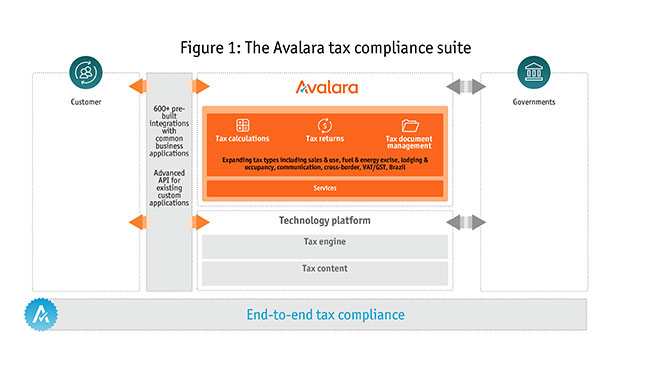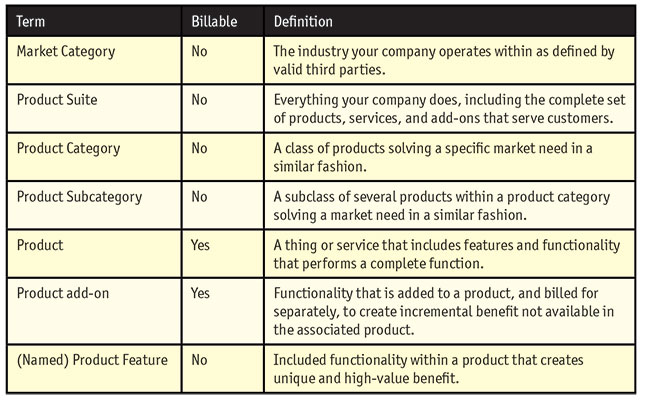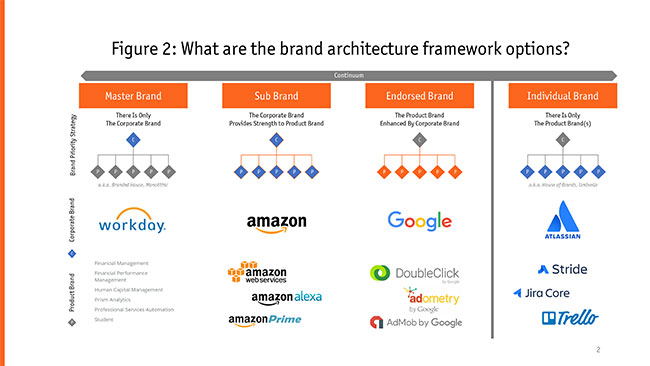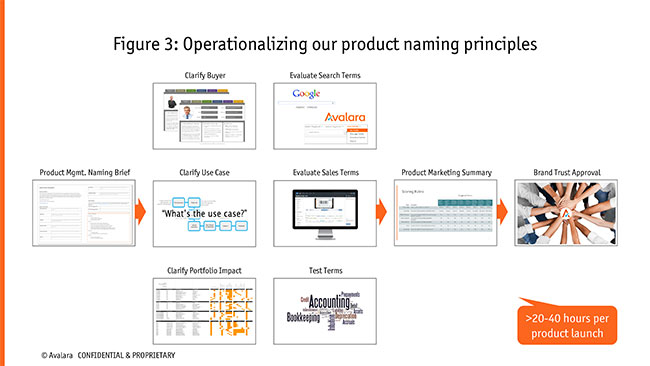No identity crisis here
Editor's note: Sanjay Puri is vice president, product marketing, at Avalara, a Seattle-based provider of tax compliance technology.
 As companies evolve and grow their businesses, it’s no secret that their product and service offerings are likely to expand as well. While growth is great for businesses, the expansion of product portfolios often requires companies to reevaluate their approach to how they define their brand and go about naming their products.
As companies evolve and grow their businesses, it’s no secret that their product and service offerings are likely to expand as well. While growth is great for businesses, the expansion of product portfolios often requires companies to reevaluate their approach to how they define their brand and go about naming their products.
When companies start, there is typically one product and one company. Many times, the name of the company and product are identical. As companies attempt to address additional customer challenges, product portfolios grow. As a result, companies find themselves grappling with how to provide a way for prospects and customers to navigate an increasingly broad portfolio of products to find the specific solutions that fit their needs.
When a company is small, employees are few and products are even fewer, employees communicate constantly. The people who define messaging are also the ones building the website and possibly selling. However, as companies and products grow, and functional organizations are formed, opportunities for misalignment multiply. A product might show up as one name on product collateral, a slightly different version on the website and a completely different name on a sales invoice. Even though these deviations appear minor (and correctable) early on, they always (absolutely always) get worse!
The company I work for, Avalara, recently experienced this exact dilemma with our expanding product portfolio. As my team and I began researching with analyst firms and other B2B SaaS companies on how to, quite simply, name our expanding portfolio of products while staying aligned with our brand promise, we quickly learned that there is no ready-made guide to product naming. It was clear to us that we were going to have to pull together disparate frameworks and methodologies to develop our own product naming principles.
However, it also became rapidly clear to us that before defining the naming principles, we would have to first establish and understand several foundational elements, including our marketecture, product catalog, brand architecture and product naming rules.
Clearly define the market
The first step in the product naming process is to define your company’s marketecture, which is a simplified, outside-in representation of a company’s place within the market. Creating a marketecture allows your team to clearly define the market in which your company operates and highlight where your products fit in the overall market landscape.

If done correctly, your marketecture should enable you to easily explain to someone outside of your company your market, business and product value-add. For example, Avalara is a provider of tax compliance technology, which is a piece of the broader tax compliance market. We sit in between businesses and governments (see Figure 1) to help manage nearly every aspect of the tax compliance process, including understanding changing tax legislation, managing tax calculations and returns, managing tax notices and supporting audit responses. The tax compliance market is historically a very manual process-driven market where governments issue regulations and businesses work to stay compliant using spreadsheets and other manual processes.
The creation of marketecture is not merely a graphic design exercise. It requires a solid understanding of the company’s products, how they align with customers’ pain points and how they solve those problems. It also requires alignment with internal organizations including product management, sales, solutions consulting and others to ensure that there’s general agreement on how we’re going to describe the company to external audiences.
Create a product catalog
Similar to the approach taken for a marketecture, the next step is to create a product catalog, which is an outside-in representation of a company’s products and services. The product catalog is not how a company views its products externally but how you want your customers and prospects to view your product offerings.
To begin cataloging products, you must first establish how you will define categories in a hierarchical fashion, beginning with the category itself and all the way down to individual products themselves. By creating an agreed upon framework of definitions for categorization, your organization can more easily determine the appropriate category for new products as they come to market. An overview of this hierarchical approach to definitions is shown in the accompanying chart.
Once you have these definitions established including whether customers pay for it or not (denoted by the Billable column), you can begin creating your product catalog by structuring the framework around the major product categories. For Avalara, our main product categories include tax calculation, tax returns, tax document management and professional services.
After each product has been mapped to the appropriate product category and subcategory, your catalog should also map out the key market attributes that align with each product. For example, these attributes can be created by asking a series of questions, including:
- What size business is this product relevant to?
- What specific business challenges does the product serve?
- What regions of the world or country is the product most relevant to?
Establishing a product catalog allows businesses to create a framework that is based on an outside-in view of its solutions. Creating this type of framework allows people across the business to better understand the products themselves and the categories they serve. This also enables your marketing team to push products and solutions to the market in a way that makes it clear to customers and prospects what the value of the product is.

Understand the framework
The next step in laying the foundation for product naming is to understand the brand architecture framework your company follows (sometimes without even knowing it). A brand architecture is a framework that guides how a corporate brand relates to a product brand. There are many variants of the framework here; it is less important which framework you follow than to follow some framework.

The first type of brand architecture is the master brand strategy. The company invests all resources and equity into a single corporate brand. Workday is an excellent example of this type of brand architecture. The company only leverages its corporate brand for all of its products and solutions. In fact, Workday barely mentions product names on its web pages or collateral.
A second type is the sub brand architecture. Under this framework, the corporate brand provides strength to the product brand, while keeping the corporate brand as a priority. A prime example of this architecture in use is Amazon. The company attaches the corporate brand to each of its product names (e.g., Amazon Alexa, Amazon Prime, Amazon Fresh, Amazon Marketplace, etc.) because the corporate brand provides an added layer of brand awareness and customer confidence in the products and services being provided.
The third category is the endorsed brand strategy. Companies that leverage this architecture enhance the product brand by endorsing it through the corporate brand. In this scenario, the corporate brand elevates the product brand through association and is typically utilized by acquisitive companies who intend to keep the acquired brand alive due to its brand equity. For example, Google acquired DoubleClick and AdMob and then referenced the acquired products as DoubleClick by Google and AdMob by Google. Interestingly, Google’s organic products continue to maintain a sub brand strategy (e.g., Google Search, Google Cloud, etc.).
The final, and perhaps most unique, category is the individual brand. In this architecture, there is no corporate brand attached to the product brand. Each product maintains its individual brand that is distanced from the corporate brand entirely. An example of this architecture in action is Atlassian. While the company has numerous products that are widely known and used by companies, many users may not even be aware that certain products (such as Confluence, Jira, Trello, etc.) are owned by Atlassian due to the branding style.
When it comes to brand architectures, companies have the ability to evolve and shift from architecture to architecture as their business evolves. Popular companies like Amazon and Google both started out as a master brand and have evolved over time into a sub brand and endorsed brand, respectively. The brand architecture you choose depends on a range of factors, including the brand awareness of your company, the industry you are in, your product set and more. For Avalara, we have adopted a sub brand strategy because the added association of our corporate brand helps prospects and customers to know that each of our products are tied to our commitment of “Tax compliance done right.”
Distinctiveness/Descriptiveness continuum
A common framework used by marketers for product naming is, quite interestingly, derived from the U.S. Patent and Trademark Office’s articulation of the Distinctiveness/Descriptiveness continuum. This continuum starts from the least distinctive to the most in five steps: generic, descriptive, suggestive, arbitrary and fanciful.
Generic. A generic approach to product naming means that a brand uses a name that describes the product category with clarity. In this approach, you use the most well-known and widely accepted terms to name and describe your product. Workday is a good example where products are named Financial Management, Human Capital Management and Financial Performance Management, where merely reading the product name clearly describes the functionality of the product.
Descriptive. A descriptive approach to product naming is essentially a generic approach with a little twist. Under this approach, you want to make it clear and obvious what the product is, but do so in a way that makes the product name unique and allows you to associate your product name with the service it provides.
A few popular examples of descriptive product naming include Gmail, Word and Photoshop. In each of these examples, the company has branded the product in such a way that it is clear what the solution provides and allows consumers to associate the product name with the service. So, instead of Microsoft naming its product simply “word processing,” the shortened branded name, Word, makes it clear what the product does and who the product is owned by.
Suggestive. A suggestive product name makes it a little more playful and does not exactly describe the product. With this approach, brand names are highly suggestive of what the product does but use abstract names to capture the attention of customers without compromising their ability to understand the intent of the solution.
For example, MailChimp is a suggestive product name for several reasons. First, it’s clear that the product has something to do with mail, specifically e-mail since it is a digital product. The playful nature of the product name points to the value-add the product offers, which is making e-mail marketing easy for everyone.
Arbitrary. An arbitrary approach to product naming uses a framework where a product name needs to have no tangible connection to the functionality of the product. However, the word itself is widely known and accepted.
Slack is a perfect example of this type of product naming. While this name has no clear connection to the communications functionality, the product is instantly recognizable due to its success and the uniqueness of the name.
Fanciful. A fanciful product name is one that has no current meaning and is often a made-up word. The benefits to this approach are that your company has the ability to own the word and trademark it. An example of this approach is the digital task management system Trello. The product name has no clear meaning but has been marketed in such a way that it is now synonymous with the service Trello provides.
Determine the implications
Each of these product naming types comes with its own level of implications on the business. You can generally determine the implications by answering the following questions:
- How much effort will it take to create awareness of the product name?
- What’s the defensibility of the product name?
When using generic names, you want to steer the customer conversations instantly past defining what you are selling to the differentiation with a competitor. On the other hand, each of the other naming types (descriptive, suggestive, arbitrary, fanciful) requires you to do some sort of education and definition around the product itself. Additionally, as you move from descriptive to fanciful, the process around defining and explaining product names becomes much more involved. With each naming type comes an added layer of marketing investment, which increases the costs around advertising, marketing collateral and general brand awareness for the product.
For Avalara, our company has a combination of product naming principles used in our portfolio. At the company brand level, the name Avalara is considered fanciful due to the fact that it is a made-up word and there are no other Avalaras. At the product level, we have historically chosen descriptive and suggestive names. However, as we went through this self-examination, we also decided that we wanted to start moving towards generic/descriptive names for our products in the future. With a distinctive name such as Avalara, it made sense to minimize the cognitive load associated with the product names.
As part of our analysis, as we researched other B2B SaaS companies and how they manage their brand and product naming relationships, we discovered that a large number of them appear to be navigating (intentionally or otherwise) towards a master brand brand architecture and generic product naming.
At the end of the day, products should be used as support elements to your company’s overarching brand. The way through which you name your products should not compete with the company brand. Each product should measure up to the company’s mission and promise to support the overarching strategy of the company.

Ensure consistency
Before you can begin applying these principles at your company, you must first define rules for how you create product naming principles to fit your business. These rules are critical to ensure consistency across all products in your portfolio. Oftentimes, these rules will be very simple, so it’s important to not overthink when creating your guidelines. For example, after all of our analysis and thinking, our product naming rules were as follows:
One company. Product names should be cohesive and fit the company’s larger narrative – for today and tomorrow. Avalara’s first rule is “One Avalara,” which helps ensure that each product name supports our narrative of “Tax compliance done right.”
Customer-centric. Product names should reflect the customer’s natural language. The language used should explain what a product does or does not do as well as the value it provides to the audience. How a product is named can either speed up the process of customer understanding or slow it down.
Global relevance. Depending on the size of your company, your product names should work across all markets, both where you are currently present and where you plan to expand to.
Find your fit. Identify the right product naming principle that allows you to explain the product value proposition. For Avalara, moving toward a generic/descriptive approach is critical for us to be able to explain the value of the product and easily tie it to the Avalara brand, which is where we have to focus a large portion of our marketing efforts with brand awareness.
Once you have rules set in place, the first step in operationalizing your product naming principles is to create a naming brief, which is a two-to-three-page document that grounds the organization on a number of items, including: what the product is; who the customers are that it serves; what pain points the customers are experiencing; how the product fits within the current portfolio; and what other market insights, like competitive positioning or selling channels, have impacted the naming.
The naming brief is the foundational element that removes all of the things that a customer or the market in general doesn’t necessarily care about so that you can focus on how to bring the product to life in a meaningful way.
Once the naming brief is in place, there are several work streams that begin behind the scenes, including:
- analyzing buyer persona research to clarify the target audience and buyer characteristics;
- clarifying the use cases for the product to understand how it can be specifically used by customers;
- understanding the impact on the portfolio and where the new product fits in;
- identifying the natural language search terms that prospects and customers will use to search for the solution the product provides;
- evaluating the sales teams and their calls to understand how the name can be used to increase conversion rates; and
- testing the audience to understand how the general audience responds to the product names.
All of this data can be very deep or surface-level depending on the amount of information your team needs, the product type, etc.
Following the completion of the work streams to understand all of the implications of the product and how to best utilize the name, the team should create a product marketing summary. The summary includes a scoring rubric that measures the effectiveness of each proposed product name to understand how each name compares to one another. This summary is shared with the brand trust approval for review and feedback. At this point in the process, the committee will either approve your recommendations or provide feedback for additional testing and request a counterproposal.
While the product naming process – from the beginning with the naming brief to the end with approvals – can be lengthy, it demonstrates several things, including the complexity that surrounds product naming and the commitment of the leadership team in being thoughtful about how new products are introduced into the market.
The product naming process involves buy-in from multiple groups across a company and is not just limited to marketing. With that being said, each product naming endeavor should be viewed as a company-wide project. It’s critical that product marketers leverage the insights, tools and processes created by other teams to help ensure that product naming is aligned to help move your company toward a more consistent voice when communicating your brand story. On the other hand, other marketing teams should leverage the agreed-upon product naming principles for your organization across ongoing programs, campaigns, internal tools, events and more to help fine-tune messaging and align closer to the brand promise.
On the right track
It’s important to remember that there is no one-size-fits-all approach to product naming. Each company has a unique mission, product set, value proposition and culture that all impact the architectures, frameworks and principles needed to clearly define and articulate your product names. As you begin identifying which product naming principles align most closely with your brand, keep in mind that as long as prospects and customers are willing to accept your name and the associated messaging, then you’re on the right track toward success.
